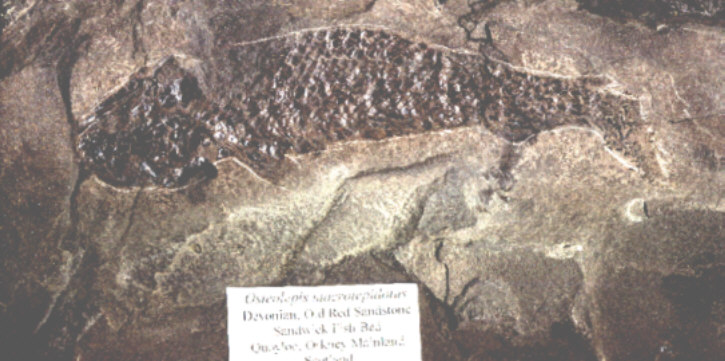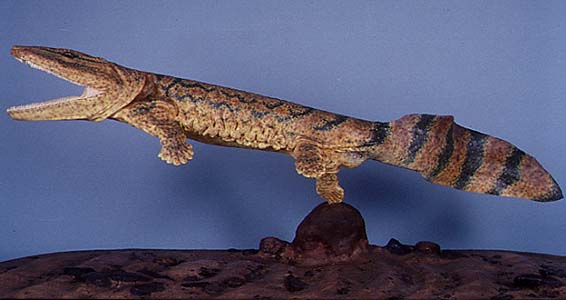| Fish to
Amphibian Transition
Copyright 1997 G.R.Morton. This may be freely distributed as long as no change is made to the text and no charge is made. Original at - http://home.entouch.net/dmd/transit.htm Creationists claim that there are no transitional forms. This claim is made over and over as if it were a mantra. The plain fact is that there are transitional sequences but they never discuss the details. This is a sequence of fossils which occupy the transition from fish to amphibian. 378 MYR ago- Panderichthys--These are lobe-finned fish. Panderichthys was a rhipidistian,osteolepiform fish. The skull bones of these fish are bone for bone equivalents to the skull bones of the earliest tetrapods. (Carroll 1988, p. 160). These are the only fish whose fin bones fit the tetrapod pattern of humerus, ulna and radius in the forelimb and femur, tibia and fibula in the hindlimb. (Thomson, 1991, p. 488), Yet these limbs still have fins on them (Coates, 1994,p. 174). Their brain case is so much like that of the earliest tetrapod, they were originally classified as tetrapods until a complete skeleton was found. Then is was proven that they were really still fish. (Ahlberg and Milner, 1994, p. 508). This fish also had lungs and nostrils (Vorobyeva and Schulze, 1991, p.87) but also had gills. These things really looked like tetrapods until you see the fins. The teeth had infolding enamel which is identical to that of the earliest tetrapods. Unlike all fish but like the tetrapods, the Panderichthys have lost the dorsal and anal fins, leaving 4 fins in the place where legs would be in the Tetrapods.(Ahlberg and Milner, p.508). This contradicts Gish's claim that there is no fossil which shows loss of fins. (Gish, 1978, p. 78-79). Unlike fish, Panderichthys had a tail, like the amphibians with the fins stretched out along the top (Carroll, 1995, p. 389; Carroll, 1996, p. 19). This is not a Panderichthys, but it is a related lobe-finned Devonian fish out of my personal collection. It gives some idea of what they looked like.
Panderichthyids and all other osteolepiform fish had a choana, a hole between the nasal passage and the mouth. This hole is missing in all other lobe-finned fish. It allowed air to pass from the nose into the mouth.. But Panderichthys also had external nostrils which were in the same position as those of the early tetrapods. (Schultze, 1991, p. 58). The lower jaws of panderichthyids had broad coronoids with fangs (Ahlberg 1991, p. 299) 370--Fish similar to Sauripterus. A very recent discovery in Pennsylvania by Daeschler and Shubin (1998, p. 133; Kinney, 1998) is of a fish which has fins, which is not unusual, except that inside of the fins were 8 fingers attached in a similar way to those of the earliest amphibians (see below). While many doubt that this creature is on the direct line of descent between fish and amphibians, the existence of fins with 'fingers' is illustrative of the fact that intermediate forms (broadly defined) do exist. Interestingly, as we shall see some of the earliest amphibians also had 8 digits on their hands. 368-Elginerpeton is a very primitive tetrapod found at Scat Craig, Scotland. Its lower jaw had coronoid fangs as did Panderichthys but they were smaller (Ahlberg 1991, p. 299). The very primitive limb bones found with it include an Ichthyostega-like tibia and an ilia and shoulder girdle comparable to the future Hynerpeton. There are no hands or feet found with the fossil so while the animal is quite tetrapod like in the parts which have been preserved, the final proof of its tetrapod status is missing. (Carroll, 1996, p. 19) 368 MYR- Obruchevichthys was found in Latvia and Russia but is only known from a partial mandible. The similarity between this mandible and Elginerpeton caused Ahlberg (1991) to reclassify this as a tetrapod. This creature also shows the coronoid fangs of the Panderichthys but they were also smaller than the panderichthyid fangs. Daeschler notes that this animal also has the parasymphysial fans of a tetrapod. (Daeschler, 2000, p. 307) 365-363 MYR -Hynerpeton-more advanced legs and pelvic girdle than Ichthyostega. (Carroll, 1996, p. 19) The coronoid fangs are not present. It lacked internal gills (Daeschler et al, 1994, p 641). There is no mention of feet having been found in Daeshler's report. The shape of the pectoral girdle implies both an aquatic and a terrestrial lifestyle. 365-363 MYR -Densignathus rowei--known only from the jaw but it is transitional between fish and amphibians. It has the parasymphysial fang of a stem tetrapod but also the coronoid fangs of a fish. As noted above Daeschler says this combination is also found in Obruchevichthys, Ventastega and Metaxygnathus. (Daeschler, 2000, p. 307). The earlier fish had a closed manidbular canal while the early amphibians had an open mandibular canal. Densignathus rowei is intermediate with a partially enclosed mandibular canal. Once again a transitional trait. 363 MYR-Ichthyostega-- Is the first animal with feet but the
feet are different than most tetrapod feet. They are much like
Acanthostega but has 7 digits on his hindlimb. His legs were only good
for being in water. They could not support his weight. (Coates and Clack,
1990, p. 67) These are half evolved legs since they have more digits than
the normal tetrapod but fewer bony rays than the fish and they are unable
to support the weight. This contradicts Gish's statement that there are no
half-evolved feet. (Gish, 1978, p. 79) . Ichthyostega had external
nasal openings and a choana like that of the Panderichthys (Schultze,
1990, p. 35). He has lungs and gills. His tail was long with fins above
and below like that Panderichthys and Acanthostega.
(Carroll, 1992, p. 46). His legs were tetrapod having humerus, ulna and
radius in the forelimb and femur, tibia and fibula in the hindlimb. (see
diagram Carroll, 1992, p. 46). 363 MYR- Acanthostega- has four legs, lungs but still has internal gills. (Coates and Clack , 1991, p. 234) He has 8 digits on his front leg (see second picture below); seven on his back feet. (Carroll, 1995, p. 389) His legs could not support his weight either. (Coats and Clack, 1990, p. 66-67). Ahlberg (1991, p. 301) points out that the front legs were more fish-like than the back legs. He has fishlike lower arm bones (Coates and Clack 1990, p. 67). Once again, contrary to Gish (1978, p. 79), these are still half-evolved legs. He also retains a caudal fin (Coates, 1994, p. 175) and an elongated tail with fins stretched out along the top. (Carroll, 1995, p. 389). The stapes, the bone which eventually became part of the hearing apparatus in tetrapods was still used for ventilation of the gills (Clack,1989, p. 426).
Acanthostega served from http://www.sciencenews.org/Sn_arc99/5_22_99/bob1a.jpg
Reconstruction of Acanthostega gunnari is reproduced here by the kind permission of Dr. Jennifer Clack One thing that the earliest tetrapods lacked were hands that could flex. We can curl our fingers and toes because of the arrangement of the tendons in our digits. None of the above tetrapods could do this simple trick because they lacked a notch in the flexor surface on the phalanges. Because of this, walking on a rocky surface, which requires the ability to curl the paws around various obstacles, would have been difficult for the early tetrapods. Acanthostega and Ichthyostega would only have been able to bend their hands slightly (Monastersky, 1999, p. 329). Thus, while they had hands, they were partially evolved hands. It wasn't until the evolution of Casineria kiddi, that these notches are found on each phalange. (Paton et al, 1999, p. 512) 350 MYR ago. Pederpes finneyae- This creature was discovered at Dumbarton, Scotland. It has 5 toes on each foot with the exception of a small relict finger/toe on the forepaw. Because of this, this creature is transitional between the later amphibians and Acanthostega and Ichthyostega discussed above (Carroll, 2002, p. 35). This creature has a primitive stapes, the bone used in hearing and it resembles that of Acanthostega rather than those of the later amphibians. The expanded triangular flair on the ribs resemble those of Ichthyostega. (Clack, 2002, p. 74). But, unlike the early tetrapods this creature has a "clearly distinguishable metatarsals that are bilaterally and proximodistally asymmetric." (Clack, 2002, p.75). This is a trait which it shares only with the later terrestrially adapted amphibians. Thus, once again, this creature shows intermediate or transitional traits. Those who erroneously claim transitional forms don't exist, haven't looked at the data. 340 MYR ago. Fully evolved amphibians. Amniator, Crassigyrinus, Loxommatoidea, Temnospondyl, Colosteidae, Acanthracosauria. References ABC News http://www.abcnews.go.com/sections/science/DailyNews/link000405.html Accessed 4-5-00 Ahlberg,P. E. 1991, "Tetrapod or Near-tetrapod fossils from the Upper Devonian of Scotland," Nature, 354:298-301. Ahlberg, P.E., 1995. "Elginerpeton pancheni and the Earliest Tetrapod Clade," Nature, 373:420-425. Ahlberg, P.E. and Andrew R.Milner, 1994"The Origin and Early Diversification of Tetrapods," Nature April 7, 1994. Carroll, Robert L. 1988, Vertebrate Paleontology and Evolution,(New York: Freeman). Carroll, Robert L.,1992. "The Primary Radiation of Terrestrial Vertebrates," Annu. Rev. Earth Planet. Sci. 1992: 20: 45-84. Carroll, Robert, 1995, "Between Fish and Amphibian", Nature, 373: 389-390. Carroll, Robert L., 1966, "Revealing the Patterns of Macroevolution", Nature, 381,pp. 19-20. Carroll, Robert L. 2002, "Early Land Vertebrates," Nature, 418:35-36. Clack, J. A. 1989."Discovery of the Earliest-Known Tetrapod Stapes," Nature, 342:424-427. Clack, J. A. 2002. "An Early Tetrapod from 'Romer's Gap'. Nature, 418:72-76 Coates M. I. and J. A. Clack, 1990.. "Polydactyly in the earliest Known Tetrapod Limbs," Nature, 347: 66-67 Coates and Clack, "Fish-like Gills and breathing in the earliest known Tetrapod," Nature, 352, July 18, 1991, p. 234-236 Coates,M.I., 1994. "The Origin of Vertebrate Limbs," Development 1994 Supplement, 169-180, p. 174 Daeschler, Edward B., et al, 1994, "A Devonian Tetrapod from North America," Science, 265:639-642. Daeschler, Edward B., and Neil Shubin, 1998, "Fish with Fingers?" Nature, 391:133. Daeschler, Edward B., 2000, "Early Tetrapod Jaws from the Late Devonian of Pennsylvania, USA,” J. Paleont. 74(2000):2:301-308, p. 307 Gish, Duane, 1978, Evolution: the Fossils say No! (San Deigo: Creation-Life Publishers). Kinney, David, 1998, "Evidence of Finges in Fish?" AP wire, Jan 18, 1998 Monastersky, Richard, 1999.“Out of the Swamps,” Science News, 155:328-330. Paton,R. L., T. R. Smithson and J. A. Clack, 1999. ”An Amniote-like Skeleton from the Early Carboniferous of Scotland,” Nature, 398:508-513, p. 512 Thomson, Keith Stewart 1991. "Where Did Tetrapods Come From?" American Scientist, 79(Nov/Dec 1991), p. 488-490, p. 488 Schultze, "Controversial Hypotheses on the Origin of Tetrapods," in _Origins of the Higher Groups of Tetrapods_, ed H.P. Schultze and L. Trueb, 1991, pp 29-67. Vorobyeva and H.P. Schultze, "Description and Systematics of Panderichthyid Fishes with comments on Their Relationship to Tetrapods," in Schultz and Trueb, 1991. Origins of The Higher Groups of Tetrapods, Comstock Publ. Assoc., p. 68-109 revised 8-6-01
|


